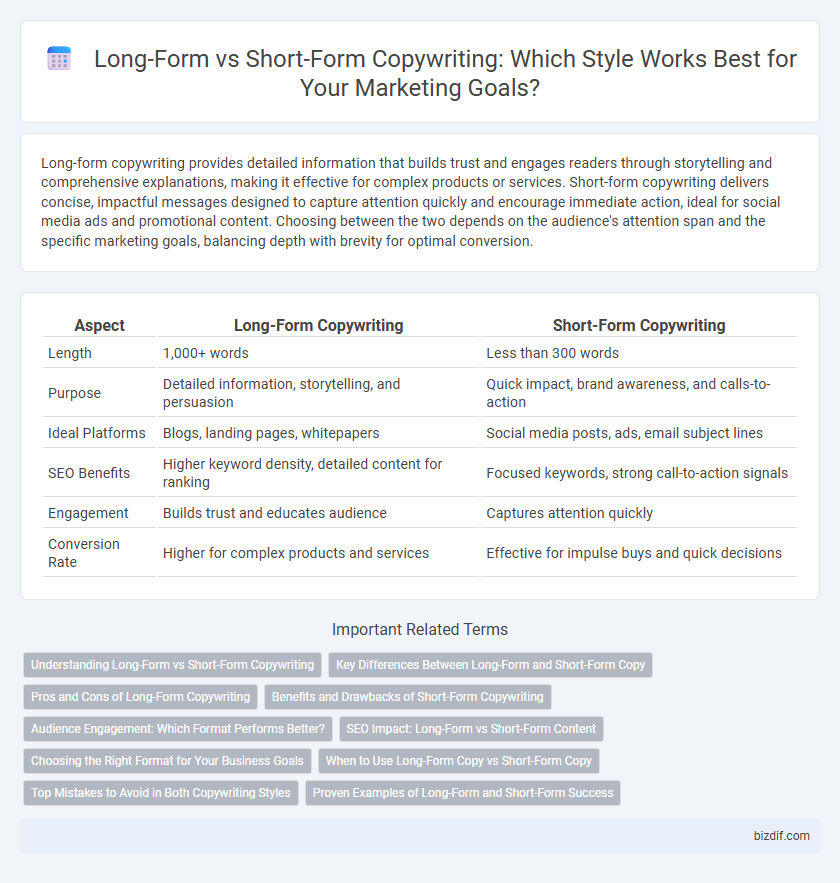Long-form copywriting provides detailed information that builds trust and engages readers through storytelling and comprehensive explanations, making it effective for complex products or services. Short-form copywriting delivers concise, impactful messages designed to capture attention quickly and encourage immediate action, ideal for social media ads and promotional content. Choosing between the two depends on the audience's attention span and the specific marketing goals, balancing depth with brevity for optimal conversion.
Table of Comparison
| Aspect | Long-Form Copywriting | Short-Form Copywriting |
|---|---|---|
| Length | 1,000+ words | Less than 300 words |
| Purpose | Detailed information, storytelling, and persuasion | Quick impact, brand awareness, and calls-to-action |
| Ideal Platforms | Blogs, landing pages, whitepapers | Social media posts, ads, email subject lines |
| SEO Benefits | Higher keyword density, detailed content for ranking | Focused keywords, strong call-to-action signals |
| Engagement | Builds trust and educates audience | Captures attention quickly |
| Conversion Rate | Higher for complex products and services | Effective for impulse buys and quick decisions |
Understanding Long-Form vs Short-Form Copywriting
Long-form copywriting typically ranges from 1,000 to 3,000 words, offering detailed information aimed at educating and persuading readers through storytelling, in-depth analysis, and comprehensive product descriptions. Short-form copywriting, often under 500 words, focuses on concise, impactful messaging designed to capture attention quickly and drive immediate action, commonly used in ads, social media, and email marketing. Understanding the differences in length, purpose, and audience engagement helps marketers choose the appropriate format to maximize conversion rates and effectively communicate brand messages.
Key Differences Between Long-Form and Short-Form Copy
Long-form copywriting typically exceeds 1,200 words and is designed to provide in-depth information, build trust, and enhance SEO through detailed storytelling and comprehensive data. Short-form copywriting, usually under 300 words, aims to deliver concise, impactful messages that quickly capture attention and drive immediate action, often used in ads or social media posts. The key differences lie in their purpose, depth of content, and intended engagement duration, with long-form better for education and brand building, while short-form excels in brevity and direct calls to action.
Pros and Cons of Long-Form Copywriting
Long-form copywriting offers the advantage of detailed storytelling, allowing brands to build deeper connections and thoroughly explain complex products or services, which often leads to higher engagement and conversion rates. However, it requires more time and resources to produce, and risks losing readers' interest if the content is not compelling or well-structured. Despite these challenges, long-form copy excels in SEO by incorporating extensive keywords and providing comprehensive information that enhances search engine rankings.
Benefits and Drawbacks of Short-Form Copywriting
Short-form copywriting excels in capturing attention quickly and delivering concise messages ideal for social media ads, email subject lines, and headlines, driving immediate engagement. Its brevity limits the ability to fully explain complex products or services, potentially reducing persuasion depth and customer understanding. Brands benefit from short-form copy's efficiency but must balance it with strategic use to avoid oversimplification and missed opportunities for detailed storytelling.
Audience Engagement: Which Format Performs Better?
Long-form copywriting generates higher audience engagement by providing in-depth information that builds trust and authority, often resulting in longer time spent on the page and increased conversion rates. Short-form copywriting captures attention quickly, appealing to audiences with limited time and driving immediate actions, particularly effective for social media and ads. Data shows that the choice between long-form and short-form copy depends on the audience's intent, with long-form favored for education and decision-making, while short-form excels in quick, targeted messaging.
SEO Impact: Long-Form vs Short-Form Content
Long-form copywriting, typically exceeding 1,200 words, enhances SEO impact by enabling deeper keyword integration, comprehensive topic coverage, and higher user engagement metrics like time on page and lower bounce rates. Short-form copywriting, under 600 words, is effective for quick messages or product descriptions but may limit opportunities for keyword diversity and detailed content that search engines favor. Search engines prioritize valuable, relevant content, making long-form pieces better suited for boosting organic rankings and capturing diverse search intents.
Choosing the Right Format for Your Business Goals
Long-form copywriting excels in providing detailed information and storytelling, making it ideal for building brand authority and nurturing leads through in-depth content like ebooks, whitepapers, and comprehensive blog posts. Short-form copywriting delivers concise, impactful messaging perfect for driving quick actions such as social media ads, email subject lines, and product descriptions that capture attention rapidly. Aligning your choice with business goals ensures long-form copy nurtures engagement for complex products, while short-form copy boosts conversions and immediate responses in fast-paced environments.
When to Use Long-Form Copy vs Short-Form Copy
Long-form copywriting is ideal for complex products, detailed explanations, and building trust through storytelling, often exceeding 1,000 words to engage readers deeply. Short-form copywriting works best for quick conversions, brand awareness, and social media ads, typically under 300 words to capture attention swiftly. Choosing the right format depends on the target audience's attention span, the marketing goal, and the stage of the buyer's journey.
Top Mistakes to Avoid in Both Copywriting Styles
Neglecting audience research and failing to tailor content leads to ineffective messages in both long-form and short-form copywriting. Overloading long-form copy with unnecessary details causes reader fatigue, while overly brief short-form content can lack persuasive depth. Ignoring strong calls to action and poor editing reduces engagement and conversion rates across both styles.
Proven Examples of Long-Form and Short-Form Success
Proven examples of long-form copywriting success include campaigns like the famous Wall Street Journal subscription pitch, which generated millions through detailed storytelling and comprehensive benefits. In contrast, short-form copywriting excels in platforms like Twitter and Instagram ads, where concise, punchy messages drive high engagement and immediate conversions. Both formats demonstrate strategic effectiveness when tailored to audience attention spans and platform dynamics.
Long-Form Copywriting vs Short-Form Copywriting Infographic

 bizdif.com
bizdif.com